Black hair natural styles | 7 Tips for Retaining Length on 4C <b>Natural Hair</b> Without Protective <b>...</b> | Blog Black Hairstyles |
- 7 Tips for Retaining Length on 4C <b>Natural Hair</b> Without Protective <b>...</b>
- MESS!! Dr Oz Doing Big Chops and Giving <b>Natural Hair Styling</b> Tips <b>...</b>
- 5 of the Worst Things to Do to <b>Natural Hair</b> - <b>Black</b> Naps
- <b>naturally</b> curly <b>hair</b> | thirstyroots.com: <b>Black Hairstyles</b> and <b>Hair</b> Care
| 7 Tips for Retaining Length on 4C <b>Natural Hair</b> Without Protective <b>...</b> Posted: 14 Jun 2014 06:00 AM PDT
Many 4B/4C naturals protective style majority of the time (sometimes 90% of the time or more) in order to retain length. It makes perfect sense. 4B/4C naturals, by definition, have strands that shrink up 75-85% (or more) into super tiny coils and kinks that go every which way. This "super shrinkage" can lead to knots and tangles, which both can in turn lead to breakage and splits during the detangling process. Protective styling mitigates that issue by stretching and bounding the hair down to the ends. That being said, some of us do not like to wear protective styles day in and day out. Some us would love to wear our hair loose, out, and big for more than a couple of days. This desire raises the questions: Can we retain length when not in a protective style? It is possible if we are talking about just a few days, but weeks or a month or more? Many will tell you that it is difficult (including me), especially the longer and finer your hair. Nevertheless, difficult does not mean impossible. If you are one wanting to wear your hair out more while still retaining some length, here are some suggestions based on a few lessons learned and mini successes I have had with that exploration:
1. Choose a stretched style that is "low maintenance" This step sounds easier said than done, but stay with me. The key is to find a style that stretches your kinks/coils (to reduce tangling and thus breakage) while also requiring little re-touch (e.g., re-twisting, re-braiding, etc.). Here are few things I do to keep my loose styles low maintenance: 1) I try to avoid twist-outs and instead turn to braid-outs. Twists do not stretch my hair as much as braids and, thus, the resulting set reverts faster. However, if I really want a twist-out, I will start from small twists (smaller twist-outs last longer) or I braid my twists for extra stretching. Check out BGLH for articles on how to make stretched or straight styles last a while. Here are just a few: 2. Decelerate "super shrinkage" with a good anti-humidity product or gel For those humid days, a good anti-humidity product or, better yet, gel makes the difference between a style that lasts a few hours and one that lasts a couple days. I have tried many anti-humidity products, and have come to the conclusion that my hair will shrink regardless but it will shrink much less and slower with the product. Gel is not immensely better, but it will just give me a bit more hold. Whatever type of product you choose, understand this: The idea is not to maintain a perfectly defined or stretched style day by day. Instead, we seek to slow down that "super shrinkage" as long as possible. No amount of anti-humidity product and gel will help me maintain a perfectly defined twist-out or braid-out in 90% or more humidity … but it will help to maintain some of my stretch. 3. Keep your hair in a "detangled" state Knots and tangles will more than likely occur, but you can keep it to a minimum. Here are a few ways to do that: 1) Over-separating your twist-out or braid-out may accelerate shrinkage, which may translate to tangles and knot formation. (In addition to tip #1, reducing these tangles and knots is another reason why I don't separate my braid-outs.) 4. Using heat is an option, but use it sparingly and WISELY Like I mentioned in tip #1, heat helps me to have a low-maintenance stretched style for up to 3 weeks, depending on the humidity. This is because my hair takes longer to revert with heat usage than without it, as is the case with most naturals. Across the web, you will find other naturals who also benefit from heat, especially via blow drying, prior to doing a braid-out or twist-out. So, heat is an option – as long as you don't overdo it and abuse it. Also, consider this: If you are a 4C natural with fine strands, you may have to use less heat (frequency and temperature) than a 4C natural with thick strands. Check out my earlier post for tips on "How to Minimize Damage When Using Heat". 5. Moisturize on the "refresh" nights Because your hair is out and free rather than in a protective style, you may find that you need moisturize more frequently. (For example: I know that for me, the duration that I can go without re-moisturizing goes from one week or so in protective styles down to a few days in loose styles.) If that is the case with you, it helps to re-moisturize – and to do it WELL – on the night that you are refreshing your stretched style … the night that you are re-twisting or re-braiding. This method will help you to avoid the inevitable shrinkage and tangles that will come if you moisturize and leave your hair loose. 6. Keep your ends oiled This tip will help to reduce the formation of splits and breakage as well as tangles and knots. Especially on my "refresh" nights, I like to soak my ends with avocado oil or another oil. I've seen the benefits of this step – that is, little to no split, crunchy, dry ends – when my hair is worn loose, and hopefully you will, too! 7. Amp up the protein deep conditioning You've probably seen us mention protein conditioning a number of times here but with good reason. For this purpose, we need all the strength and elasticity we can get when not protective styling, and protein conditioners can temporarily provide both, especially to our ends. These types of conditioners can help our hair to be better prepared for styling manipulation and consequently avoid breakage. If you are protein sensitive, check out Jc's post on "5 Conditioners for Protein-Sensitive Hair". How do you retain length when you are not protective styling?
ChinweHails from a great city in the Midwest and will forever be a Bears fan. |
| MESS!! Dr Oz Doing Big Chops and Giving <b>Natural Hair Styling</b> Tips <b>...</b> Posted: 13 Jun 2014 04:55 AM PDT Another day, another instance of cultural appropriation folks jumping on the natural hair bandwagon to gain popularity. On May 28th, the popular daytime doctor Mehmet Oz sprang head first into a two-part show segment called Style Your Natural Hair. Here's a brief rundown of parts 1 and 2: Part 1 Dr. Oz opens talking about a "hair revolution" that even Oprah has gotten in on (shows infamous O Magazine cover where Oprah is sporting an obviously overstated textured wig). Marie Simone Smith is introduced as someone "leading the charge" in the natural hair movement (stick a pin riiiiight there) and owner of one of the first natural hair salons in the country. Sonya, a studio guest comes on stage, and explains her decision to want to big chop — among other things citing being tired of the cultural stigma that "nappy is tacky and straight is great". Stylist Marie Simone Smith (with the assistance of Dr. Oz) places Sonya's hair in a high ponytail and chops it, to much fanfare and applauses. Sonya emerges with an almost instant, beautiful stretched fro. Dr. Oz revels in the difference between her thin, relaxed ends and the thicker, more dense natural hair (comparing the densely packed strands to that of a paintbrush). Part 1 ends with an introduction to Lisa, who has been dying her hair blonde for nearly 30 years and is concerned about damage (side eye). Dr. Oz drums up interest for the next section of the segment by introducing "the perfect test" for checking hair damage. Part 2 Part 2 opens with Dr. Oz, Lisa, and Marie Simone Smith. With a sense of urgency, Dr. Oz introduces something that we all must do — called the "10 Second Healthy Hair Test". Marie Simone Smith proceeds with plucking one of Lisa's blonde, straight hairs and placing in a cup to perform a porosity test (stick another pin there, please). Smith concludes that Lisa's hair is damaged and recommends a simple fix — when you buy your "mainest" products (another side eye) aka shampoo and conditioner, look for labels that say "deep moisturizing", "deep penetrating moisturizing", or "porosity control" (you guessed it, stick another pin right there). Lisa leaves the stage and on walks Cicely, who appears to be rocking a gorgeous twistout. She gives a moving statement about being liberated and finding herself in natural hair. When Dr. Oz asks Marie Simone Smith about styling natural hair differently, Smith simply draws up Cicely's hair into a half pompadour with bobby pins (one last pin right there, please). I don't know about you all, but I almost keeled over like five times watching both clips. For the record, I don't have a problem with mainstream publications and programs joining in on the natural hair narrative. However, there is a fine line between inclusion and co-optation. This show segment is dangerously close to becoming the later, in the same vein of other habitual line steppers. The fact that a daytime show like Dr. Oz is willing to yet again talk about natural hair (they did it in 2013 with Curly Nikki), is a demonstration in the viability and power of the topic itself. However, there are so many components of this segment that are problematic and reek of ill-preparedness and ignorance on behalf of the show's producers. So let's run through those pins (I'm not even going to touch the Oprah wig thing, that magazine cover got run into the ground) while I share with you where and why I took issue with several components of this segment: Who the heck is Marie Simone Smith? I don't know about you all, but when someone is tasked or attributed to "leading the charge" of something, most people to a degree know who they are. I'm sure Ms. Smith is a stylist somewhere, and quite possibly one of the first in natural hair. But a leader in the natural hair community or revolution? Leaders in natural hair aren't hard to find. Ms. Smith on the other hand, is. I couldn't find a website, StyleSeat, Facebook, blog mention or anything. Most popular stylists have some sort of online presence, if for no other reason than to draw customers. I'm not trying to shade or discredit her, but there are a lot more trusted names that could have been called on — and some of the names in this article (like Diane C. Bailey, Anu Prestonia, or Felicia Leatherwood) are just a start. A natural hair professional from a Devachan, Ouidad or heck, even Miss Jessie's salon would have made a huge difference in lending some credibility to the segment. TV sensationalism doesn't tell the full story. In part 1, it is obvious that Sonya has transitioned (for an undisclosed amount of time) from relaxed hair. There was no mention of it, other than Sonya saying she had been waiting for a while to big chop. Additionally, her hair was obviously stretched or blown out in preparation for the show. Once the ponytail was set and chopped, Sonya emerged with a picturesque afro stretched to the gawds. I find this problematic for a few reasons: 1. It creates an unrealistic expectation for women big chopping. There are enough insecurities surrounding cutting off most of one's hair, and showcasing an aesthetic that is only achieved after transitioning for at least 6-8 months without any mention of transitioning or gradually growing hair out is misleading. 2. What about the shrinkage? Because the hair is blown out, Sonya has no clue what her hair will look like come wash day — which brings me to my next point. 3. The cut itself. Although there's more than one way to chop the hair, as someone who transitioned then cut, I couldn't help but cringe at the chop Sonya was given. I'm a firm believer in the DevaCut method, or at minimum, the idea of cutting hair in its most natural state. Our hair has all sorts of tricks up it's sleeves — shrinkage, multiple textures, and varying patterns all on one head. Cutting hair that is completely dry and stretched does nothing to accurately capture how the hair will look during regular styling — unless it will remain perpetually stretched. About that porosity test…. Time and time again, the wonderful scientist Jc of The Natural Haven has debunked and offered sound scientific reasoning behind why the porosity test is junk science. Knowing and learning hair porosity is important, but a 10 second float test in a cup of water won't tell you any more about your hair than a chart with numbers and letters and hair types will. There is no magic bullet to learning and understanding your hair, and no magic potion to correct years of damage and inappropriate care. Both require patience, and trial and error — but I guess that doesn't make for good daytime TV. The "Mainest" Products In addition to mainest not being a word, I found the product recommendations to be completely unhelpful. If someone were truly looking to Dr. Oz for help with natural hair, vague suggestions about deep penetrating and porosity control products would have put them on a fast track to nowhere. Beyond that, shampoos and conditioners related to porosity control are often only found at beauty supply and salon stores, not Target and CVS. For color care specifically, a number of drugstore (Pantene, Tresemme, Dove, L'Oreal) and readily accessible salon brands could have been mentioned — because color care products automatically attempt to address the porosity issues caused by dying hair. Also, mentions of sulfate-free products, deep conditioning, and reconstructive treatments would have been helpful, but went un-discussed. Good thing we have blogs and vlogs for this kind of stuff. And the pompadour! First things first. I don't know about you all, but I found Cicely's twist or braid out (I can't tell which one it is) to be absolutely stunning. The mix of frizz, volume, and definition looks like something that could only be achieved with day 2 or 3 hair. And then….the stylist Marie Simone Smith goes and rolls all that natural gorgeousness into an updo. If that was my hair, the show would have had to go off the air for a few minutes. When the segment approached styling, a better idea perhaps would have been taking the first guest who big chopped, Sonya, and styling her hair. A twistout demo, an updo demo, or even a wash and go demo. Not pinning up someone else's style that had at least 2 good days left! To sum it up, the segment had potential, but got lost in the shuffle of sensationalizing, gross misrepresentation and misinformation. The final product showed just how uneducated the producers were on the topic of natural hair. Dr. Oz himself was actually the singular ray of hope in this segment. For me at least, he maintained a respectful distance from the topic, asking questions, with what seemed to be genuine interest in understanding. I appreciate his willingness to stay in his own lane, and not commandeer a topic he knows little to nothing about. He successfully avoided coming across as a museum curator, circus ringmaster or in any form that would give viewers the impression that women with natural hair are a spectacle to behold. But the show producers? Get your cultural competency weight up — at least as it pertains to natural hair. Would you let Dr. Oz big chop your hair, or nah? What do you think of mainstream media outlets talking more and more about natural hair?
Christina PatriceBorn, raised, and living in Los Angeles, Christina is BGLH's resident transitioning expert and product junkie. In addition to loving all things hair, she is a fitness novice and advocate of wearing sandals year-round. For more information on transitioning, natural hair, and her own hair journey, visit maneobjective.com. Or, if you like pictures follow Christina on Instagram @maneobjective. |
| 5 of the Worst Things to Do to <b>Natural Hair</b> - <b>Black</b> Naps Posted: 23 Jun 2014 06:13 AM PDT Too Much HeatThe misuse of heat tools can slowly damage your hair. Even a one-time application with scorching heat can permanently kill your hair. Try methods for providing curl, such as wrapping at night, satin covered rollers or twist styles. Using moderate heart occasionally should be safe, but always use a heat protectant as a barrier between the hot tool and your hair. BleachingWhen it comes to black hair, bleaching does it no good. Typically, going platinum blonde takes its toll on your strands. However, natural hair can sometimes withstand extreme lightening with heavy and frequent conditioning. If you do choose to go this route, do not skip on your frequent conditioning treatments – it can determine the health of your hair. Stripping RelaxersIf you are transitioning and want to get rid of that relaxed hair, your only options are to slowly cut it off as your hair grows, or the big chop. You cannot chemically strip a relaxer. Once you apply relaxer to your hair it is permanently changed. So no amount of dish detergent, harsh shampoo products or other harsh chemicals will do your hair any justice. In fact, you're doing more harm than good. Transitioning takes time. If you don't have the patience to transition, you surely won't have the patience to care for and maintain a natural mane. Holding on to Split EndsSometimes it's difficult to chop off hair length, especially when your goal is to grow long locks. Unfortunately, some women choose the to walk around with unhealthy hair that shows. If you have split ends, trimming them will definitely do your hair some good and will ultimately result in your hair growing healthier. Let's face it, split ends are obvious and the are not cute. So do yourself and your hair a favor by trimming those ends! Rough HandlingEveryone experiences tangling of their hair at some point. How you handle them determines whether you keep your hair or whether you pull it out. Don't pull and yank at tangles. First, try to work through them gently with your fingers, and then follow with a wide-tooth comb. Make sure to detangle while your hair is slippery and lubricated- preferably after shampooing and applying conditioner. Don't try to detangle if you are in a hurry. Save that step for when you have time to slow down and do things gently. After chemically relaxing her hair for 23 years, Neisha decided begin her natural journey in 2012 and hasn't turned back. She loves to see other women embrace their natural beauty and enjoys sharing natural hair care tips with others! You can connect with Neisha on her website www.itsacinchvas.com.
Topics |
| <b>naturally</b> curly <b>hair</b> | thirstyroots.com: <b>Black Hairstyles</b> and <b>Hair</b> Care Posted: 23 Jun 2014 05:18 PM PDT 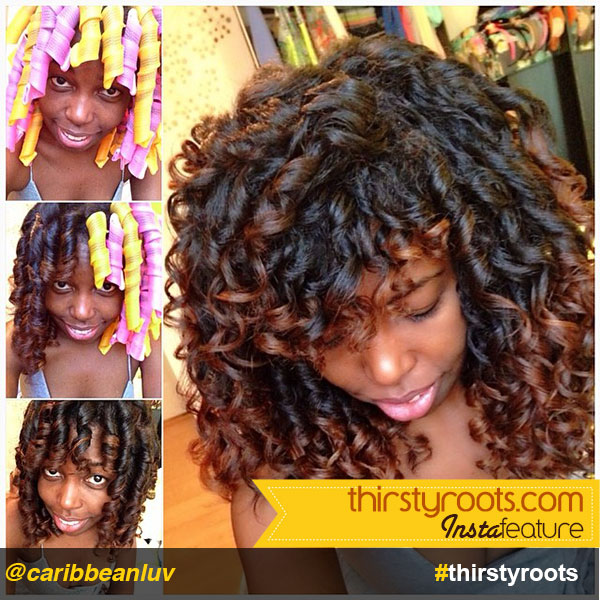 Curlformers on naturally curly hair – Caption: "Heat free curls! They're so #FLUFFY!! Brought my #curlformers out of hibernation and used @soultanicals mane thick creamy slick 7 day styler from my #curlboxnatural" ThirstyRoots.com InstaFeature @caribbeanluv shares her deeply textured naturally curly hair and styling choices with us. She is just having fun with hairstyling on her natural curls with bantu knots, two strand twists, and simple side ponytails, of which, she has been wearing since a kid:
Braid out:
Finger Coils side bangs:
Tight finger coils:
Flat ironed and curled:
Two strand twists:
Bantu knot out:
More pics:
Category: InstaFeature, Natural Hair |
| You are subscribed to email updates from Black hair natural styles - Google Blog Search To stop receiving these emails, you may unsubscribe now. | Email delivery powered by Google |
| Google Inc., 20 West Kinzie, Chicago IL USA 60610 | |
@
Tagged @ african american 2014 bob hairstyle
Tagged @ African American Men Hairstyles
Tagged @ African American Women Hairstyles
Tagged @ Black Female Hairstyles













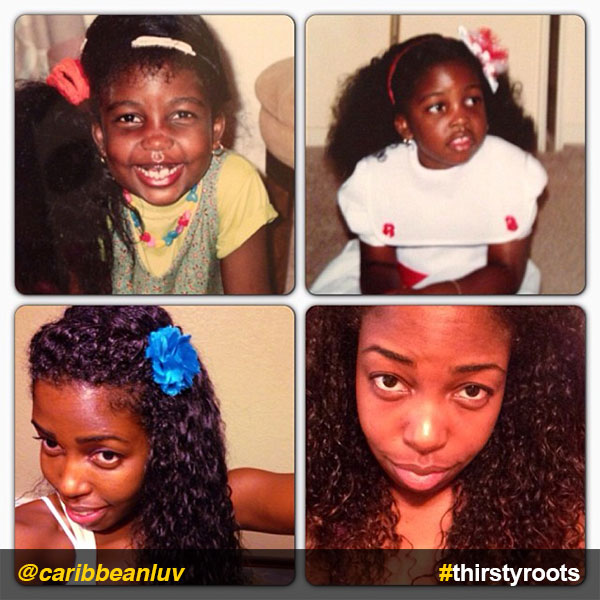
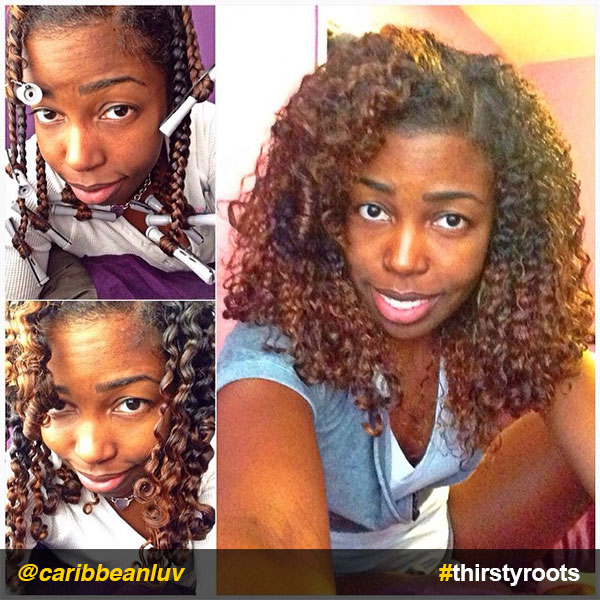
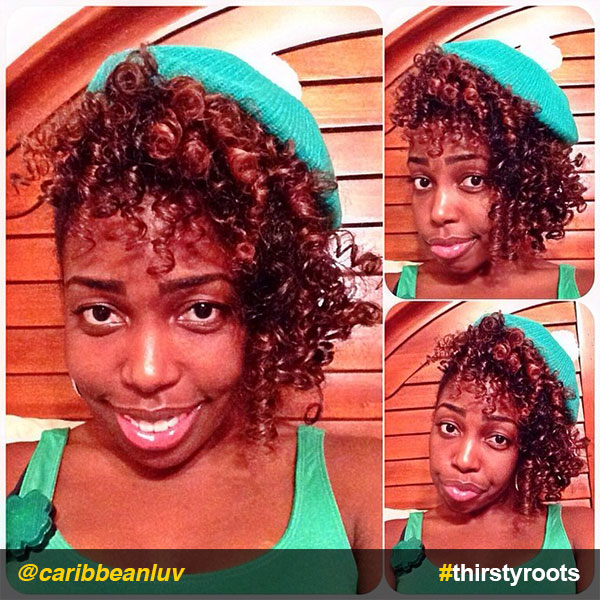
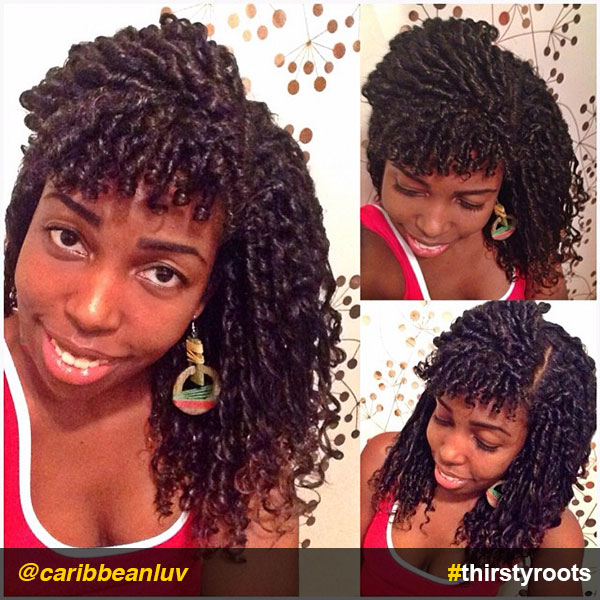
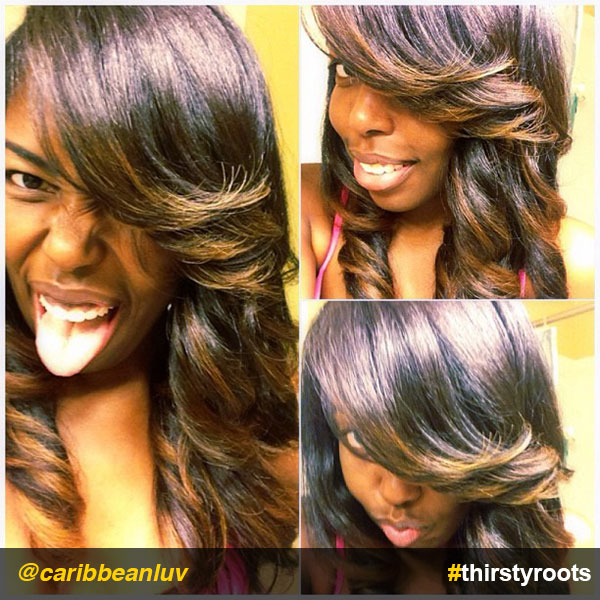
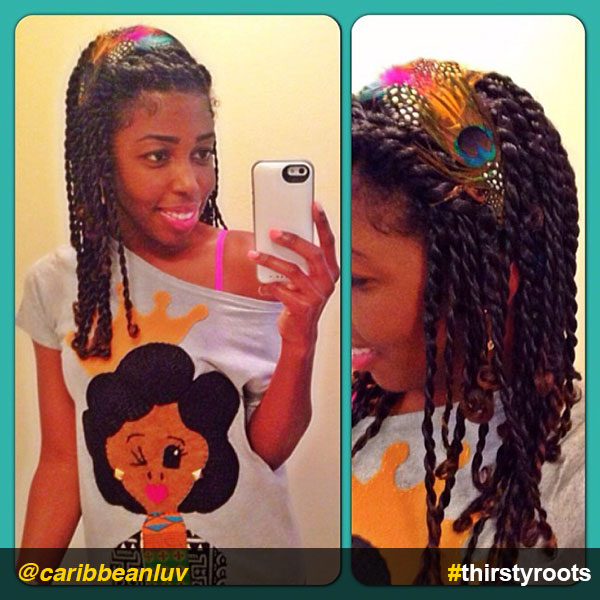
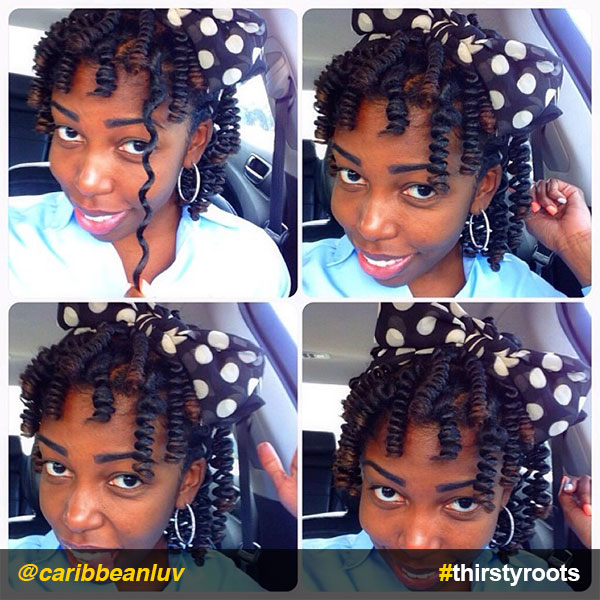
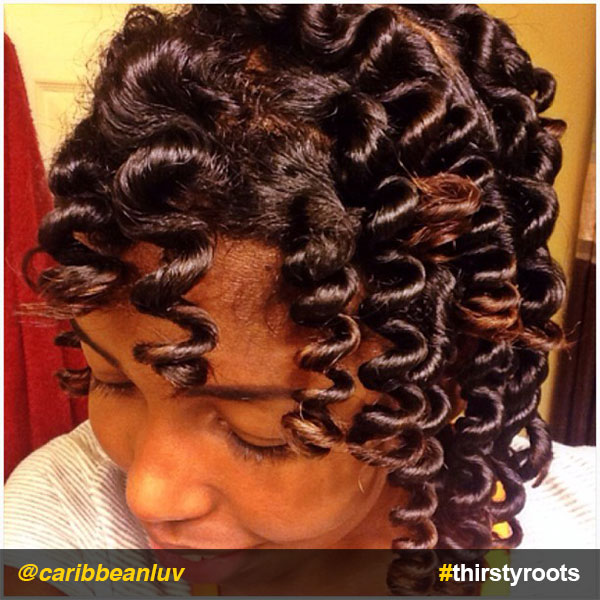
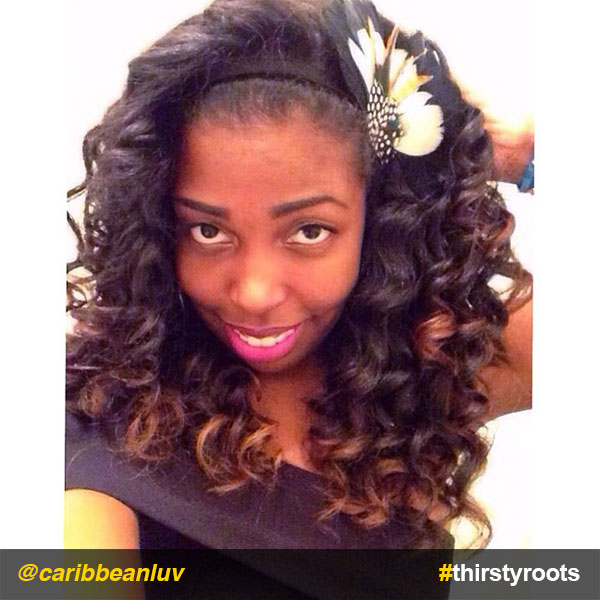
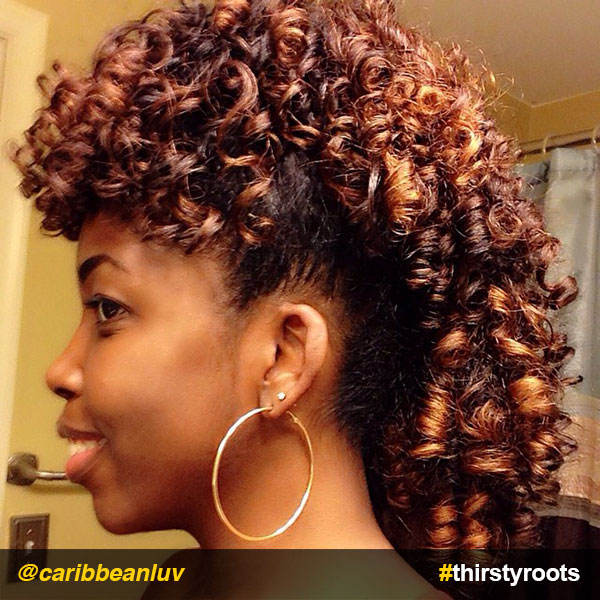
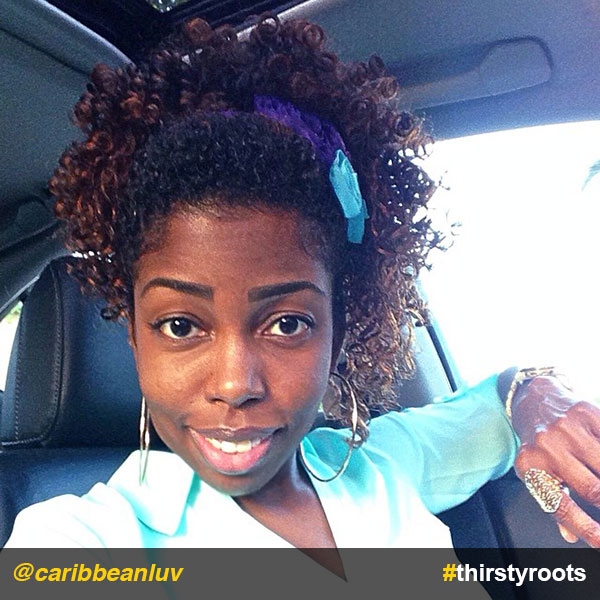

0 comments:
Post a Comment - Back to Post